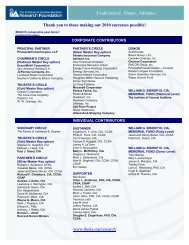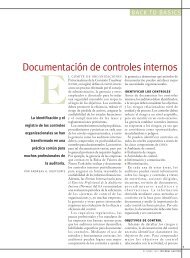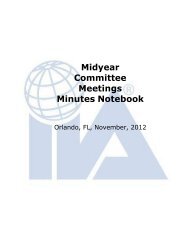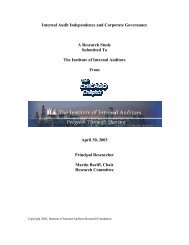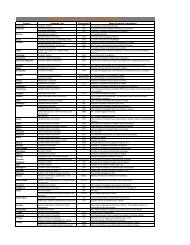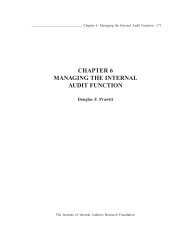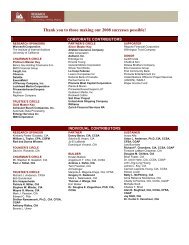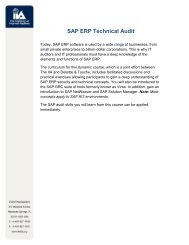Chapter 1.pmd - The Institute of Internal Auditors
Chapter 1.pmd - The Institute of Internal Auditors
Chapter 1.pmd - The Institute of Internal Auditors
Create successful ePaper yourself
Turn your PDF publications into a flip-book with our unique Google optimized e-Paper software.
6 Research Opportunities in <strong>Internal</strong> Auditing _________________________________<br />
Subsequently, in 1971, as chairman <strong>of</strong> the Research Committee, Lawrence Sawyer assumed<br />
the task <strong>of</strong> successfully revising the Statement <strong>of</strong> Responsibilities. <strong>The</strong> Statement <strong>of</strong><br />
Responsibilities underwent further revisions in 1976, 1981, and 1990 to reflect the continuing<br />
and rapid evolution <strong>of</strong> the internal auditing pr<strong>of</strong>ession.<br />
In 1978, <strong>The</strong> IIA formally approved the Standards for the Pr<strong>of</strong>essional Practice <strong>of</strong> <strong>Internal</strong><br />
Auditing (Standards), which had the following purposes:<br />
“1. Assist in communicating to others the role, scope, performance, and objectives<br />
<strong>of</strong> internal auditing.<br />
2. Unify internal auditing throughout the world.<br />
3. Encourage improved internal auditing.<br />
4. Establish basis for consistent measurement <strong>of</strong> internal auditing operations.<br />
5. Provide a vehicle by which internal auditing can be fully recognized as a<br />
pr<strong>of</strong>ession.”<br />
<strong>The</strong> Standards contained the following definition and objective <strong>of</strong> internal auditing:<br />
“<strong>Internal</strong> auditing is an independent appraisal activity established within an<br />
organization as a service to the organization. It is a control which functions by<br />
examining and evaluating the adequacy and effectiveness <strong>of</strong> other controls. <strong>The</strong><br />
objective <strong>of</strong> internal auditing is to assist members <strong>of</strong> the organization in the effective<br />
discharge <strong>of</strong> their responsibilities. To this end, internal auditing furnishes them with<br />
analyses, appraisals, recommendations, counsel, and information concerning the<br />
activities reviewed. <strong>The</strong> audit objective includes promoting effective control at<br />
reasonable cost.”<br />
<strong>The</strong> Standards also laid out the criteria, using which, internal audit department operations<br />
should be evaluated and measured. <strong>The</strong>y covered various aspects <strong>of</strong> internal auditing within<br />
organizations such as independence, pr<strong>of</strong>essional pr<strong>of</strong>iciency, scope <strong>of</strong> work, performance<br />
<strong>of</strong> audit work, and management <strong>of</strong> the internal audit department. Standards interpretations<br />
were enshrined in Statements on <strong>Internal</strong> Auditing Standards (SIAS); some examples <strong>of</strong><br />
these were specific SIAS focusing on control concepts, risk assessment, preventing and<br />
investigating fraud, relationships with independent auditors, communication with board <strong>of</strong><br />
directors, assignment planning, and follow-up on audit findings.<br />
By this time, in terms <strong>of</strong> planning, fieldwork, and reporting, the basic steps in an operational<br />
audit had been sequenced as follows: perform a preliminary survey; develop the audit program;<br />
perform the fieldwork; prepare the working papers; develop a list <strong>of</strong>, and prioritize, audit<br />
<strong>The</strong> <strong>Institute</strong> <strong>of</strong> <strong>Internal</strong> <strong>Auditors</strong> Research Foundation



